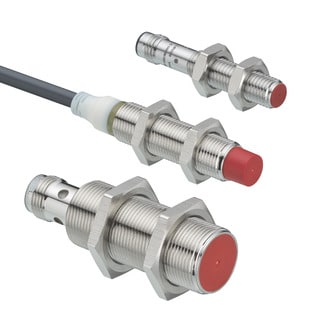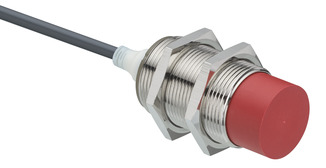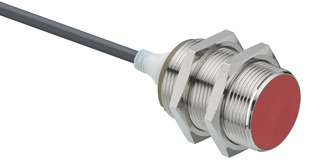Inductive switches
The Leuze product range includes a wide variety of standard and special sensors that are available in many different designs and have already been tried and tested millions of times by our customers.
In particular our extremely robust all stainless steel sensors, sensors with extended switching distance or miniature sensors for extremely constrained spaces have again and again proven to be ideal for challenging applications.
Inductive sensors with IO-Link standard v1.1.4
With an IO-Link interface, sensors can be seamlessly integrated into automation systems. The inductive proximity switches with IO-Link interface are easy to operate, parameterize and monitor (condition monitoring). They can be operated both in standard I/O mode (SIO) and in IO-Link mode, offering maximum flexibility.
Configuration options:
- Setting the switching distance and hysteresis
- Timer functions for specific applications
- Advanced functions such as temperature alarms and frequency monitoring
Advantages for you
SIO mode is the default mode, but when connected to an IO-Link master, IO-Link mode is automatically switched on, allowing the sensor to be operated and configured via the master. These configuration settings are retained even after the sensor is unplugged.
- Avoidance of machine downtimes: Continuous status monitoring of the sensors detects errors before they disrupt the production process.
- Fast reactive maintenance: Immediate identification of machine errors, which considerably speeds up the replacement of sensors.
Further information on inductive sensors with IO-Link
Go directly to article selection: Inductive sensors with IO-Link

Inductive sensors with impressive cost-effectiveness for industrial automation
The IS D Eco series’ inductive sensors offer a universal and reliable solution for the contactless detection of metallic objects in various industries. The portfolio includes the cylindrical designs M8, M12, M18 and M30 in the embedded and non-embedded installation variants. The sensors are easy to install thanks to their external thread and are UL-certified to meet the requirements of international standards. The excellent price-performance ratio makes the IS D series a cost-effective solution for projects with a large number of sensors.
Advantages for you
- For a wide range of applications in various industries
- Excellent price-performance ratio
- Up to 2x switching distance
- Common cylindrical designs with external thread
- Robust bending protection (for cable variants) for variable applications
- UL-certified

Inductive sensors with long operating range: For switching distances up to 40 millimeters
Inductive sensors, also called proximity sensors, are known for reliably detecting metallic objects over short distances. Models with increased switching distances enable operating ranges up to three times longer than standard inductive sensors. The sensors are therefore also suitable for applications with small installation spaces and/or large distances or tolerances – for example with inaccurate alignment, mechanical play or vibrations.
The robust sensors with the designation IS 200MM.2 are made of nickel-plated brass and are available in cylindrical M12, M18 and M30 housings. They can even be used under high mechanical stress and provide highly accurate measurements and repeatability at a good price-performance ratio. The sensors with switching distances of up to 40 millimeters can be installed quasi-flush or non-flush, depending on the respective application. The sensors expand the existing inductive product portfolio.
Advantages for you
- Cost-effective detection of metallic objects
- High switching distance enables machine concepts with larger tolerances
- Sensor installation at greater distances from the object reduces collisions
- Lower storage costs: Sensor models can be used for different ranges
- Robust design: Use in harsh environments with dirt or vibrations
- Mounting options for different applications: quasi-embedded and non-embedded
- Temperature range up to 70°C
Further information on inductive sensors with long operating range
Go directly to article selection: Inductive sensors with long operating range

Article list
- Series: D30
- Design: Cylindrical, 30 mm
- Typ. operating range limit Sn: 30 mm
- Voltage type: DC
- Series: D30
- Design: Cylindrical, 30 mm
- Typ. operating range limit Sn: 30 mm
- Voltage type: DC
- Series: D30
- Design: Cylindrical, 30 mm
- Typ. operating range limit Sn: 15 mm
- Voltage type: DC
- Series: D30
- Design: Cylindrical, 30 mm
- Typ. operating range limit Sn: 15 mm
- Voltage type: DC
- Series: D30
- Design: Cylindrical, 30 mm
- Typ. operating range limit Sn: 15 mm
- Voltage type: DC
- Series: D30
- Design: Cylindrical, 30 mm
- Typ. operating range limit Sn: 15 mm
- Voltage type: DC
- Series: D30
- Design: Cylindrical, 30 mm
- Typ. operating range limit Sn: 10 mm
- Voltage type: DC
- Series: D30
- Design: Cylindrical, 30 mm
- Typ. operating range limit Sn: 10 mm
- Voltage type: DC
- Series: D18
- Design: Cylindrical, 18 mm
- Typ. operating range limit Sn: 16 mm
- Voltage type: DC
- Series: D18
- Design: Cylindrical, 18 mm
- Typ. operating range limit Sn: 16 mm
- Voltage type: DC
- Series: D18
- Design: Cylindrical, 18 mm
- Typ. operating range limit Sn: 16 mm
- Voltage type: DC
- Series: D18
- Design: Cylindrical, 18 mm
- Typ. operating range limit Sn: 16 mm
- Voltage type: DC





















